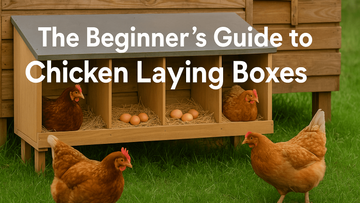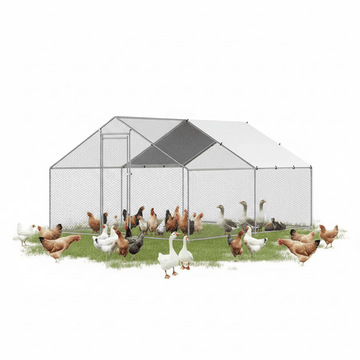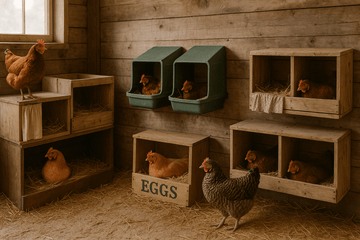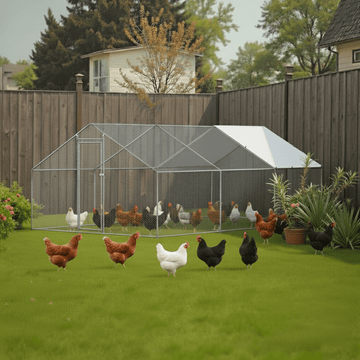Raising backyard chickens is a rewarding adventure, and one of the key components to ensure your hens are comfortable and productive is providing proper chicken laying boxes. These boxes are more than just a place for hens to drop their eggs; they are crucial for creating a stress-free, clean, and safe environment that encourages regular egg laying. Whether you’re a hobbyist with a few hens or just starting a small flock, understanding the basics of nesting boxes can make all the difference. In this guide, we’ll cover everything from choosing the right box to keeping your hens happy and your eggs clean. Let’s dive in.
Why Chicken Laying Boxes Matter
Importance for Egg Production
If you’re raising chickens for eggs, the laying box for chickens is essentially the hen’s office—a dedicated place where she can do her job in peace. Without proper nesting boxes, you might find eggs scattered all over the coop, in mud, or even broken. A well-designed box encourages hens to lay in the same place consistently, making egg collection easier and more sanitary.
Moreover, nesting boxes reduce the chances of hens developing bad laying habits, like laying eggs on the floor or in corners. A consistent laying spot keeps eggs clean and reduces breakage, which is especially important if you plan to sell or share your eggs.
Comfort and Safety for Hens
Comfort plays a huge role in how productive your hens will be. Think of the nesting box as a cozy bedroom: if it’s too noisy, bright, or cramped, your hen won’t want to settle down. A comfortable, dark, and quiet space mimics the secluded environment hens naturally seek in the wild for egg laying.
Nesting boxes also provide safety. When hens lay in open spaces, they’re vulnerable to predators, stress, and pecking from other hens. A proper box gives them a secure retreat, reducing anxiety and helping them lay better, more frequently.
Choosing the Right Type of Chicken Laying Box
Wood vs. Plastic vs. Metal
Each material has its pros and cons. Wooden boxes are traditional and easy to build at home. They’re breathable and insulate well in cold weather. However, they can also harbor mites and are harder to clean. Plastic boxes are lightweight, easy to sanitize, and resistant to parasites. They’re ideal if cleanliness is a top priority. Metal boxes are durable and great for large flocks, but they can be cold in winter and may need extra insulation or padding.
Your choice depends on your climate, number of chickens, and how much maintenance you’re willing to do.
Commercial vs. DIY Options
Commercial laying boxes are often designed with roll-away egg features, ventilation, and even slanted floors. They’re ideal for beginners who want a plug-and-play solution. But if you enjoy a hands-on approach or want to save money, DIY nesting boxes made from old crates, buckets, or storage bins can work just as well.
The main thing is to ensure the box is sturdy, easy to clean, and private enough for hens to feel secure. A good nesting box doesn’t have to be fancy—just functional and comfy.
How Many Nesting Boxes Do You Need?
Hen-to-Box Ratio
A general rule of thumb is one nesting box for every 3–4 hens. This prevents competition and reduces the chance of hens laying outside the boxes. While you might be tempted to provide one for each hen, that’s usually unnecessary and takes up extra space.
Interestingly, even when multiple boxes are available, hens often share one or two favorites. It’s like they have a club—the more popular the box, the more everyone wants to use it.
Avoiding Overcrowding Issues
When there aren’t enough boxes, hens may crowd into one box, leading to broken eggs or squabbles. Worse, some hens may stop laying altogether due to stress. Ensuring you have enough boxes, spaced out evenly in the coop, helps maintain order.
You can also rotate and clean boxes frequently to prevent them from getting too “popular,” and encourage hens to use all available options. Check out this detailed guide about How Many Nesting Boxes Per Chicken Do You Need.
Ideal Placement for Laying Boxes
Indoor vs. Outdoor Placement
Always place nesting boxes inside the coop. Outdoor boxes might be easier to access for egg collection, but they expose hens to predators, rain, and temperature fluctuations. An enclosed coop area keeps the boxes dry, secure, and warm.
In colder climates, indoor boxes also help maintain a stable temperature, which can affect laying habits.
Height and Accessibility Considerations
Place boxes about 18 to 24 inches off the ground. This height is perfect—it’s not too low for pests or too high for older hens to reach comfortably. Ensure there’s a small perch or step in front of each box to help hens get in easily.
Avoid placing boxes above the roosting area. Chickens might sleep in the boxes if they’re higher up, which leads to dirty nesting areas—not ideal for clean eggs.
Designing the Perfect Nesting Box
Dimensions and Size Guide
Each nesting box should be roughly 12” x 12” x 12” for standard breeds. Larger breeds like Orpingtons may need slightly bigger spaces. A too-small box will make hens uncomfortable, and they might lay elsewhere. Too large, and they may crowd together, risking broken eggs.
Use dividers to give each hen her own space. Think of it like a cubicle office for your feathery coworkers—everyone needs their own zone.
Privacy and Darkness for Better Laying
Chickens prefer secluded, dimly lit areas to lay eggs—it’s part instinct and part comfort. If a nesting box is too exposed or bright, hens might feel vulnerable and choose not to lay there. Use simple curtains or flaps made of burlap or fabric to provide a sense of privacy. These curtains also help block light, making the interior of the box darker and more inviting.
The key is to mimic the natural conditions a hen would seek in the wild. When hens feel hidden and secure, their stress levels drop, and egg production becomes more consistent. Don’t be surprised if your hens suddenly start favoring the curtained box over the open ones.
Also, keep the boxes away from high-traffic areas inside the coop. Noise, movement, or other birds milling around can disturb laying hens. The more peaceful the environment, the better your egg yield.
Proper Ventilation and Insulation
While you want your boxes to be private, they shouldn’t be stuffy. Ventilation is crucial to prevent mold and moisture buildup, especially in wood boxes. Make small, screened vents near the top of each box to allow airflow without drafts. This keeps the nesting material dry and the air fresh, reducing the risk of respiratory issues or moldy eggs.
Insulation matters too, especially in extreme climates. In colder months, insulated walls can keep hens warm and more willing to enter the box. In summer, ensure the boxes aren’t in direct sunlight and have enough airflow to stay cool. Proper climate control inside the boxes is a game-changer for year-round egg production.
Bedding and Nesting Materials
Best Materials to Use
The right bedding can make a huge difference in both hen comfort and egg cleanliness. The top materials to consider include:
- Straw: Soft, natural, and easy for hens to manipulate into a nest.
- Wood shavings: Absorbent and easy to clean; pine shavings are best.
- Shredded paper: Recycled and eco-friendly, but less absorbent.
- Nest pads: Reusable, washable pads that offer great hygiene.
Straw is the go-to for many backyard chicken keepers because it mimics natural nesting materials and retains warmth well. Just ensure it’s clean and dry—damp straw can harbor bacteria and mold.
Materials to Avoid
Avoid using hay, as it tends to mold quickly and can carry harmful spores. Also, stay away from cedar shavings—while they smell good, they release aromatic oils that can irritate chickens' respiratory systems.
Don’t use synthetic fabrics or anything with loose threads, which could entangle your hens or their feet. The goal is clean, dry, and natural. If you notice bedding becoming clumped, moldy, or smelly, replace it immediately.
Keeping Bedding Clean
Clean bedding equals healthy hens and clean eggs. Scoop out soiled materials at least once a week, or more often during rainy seasons or in humid climates. Add fresh layers regularly and check for signs of lice or mites hiding in the corners of boxes.
Sprinkling a little diatomaceous earth in the bottom of each box can help prevent infestations and absorb moisture. Consider using removable liners or pads for quick cleaning and replacement—this small step can save a lot of time and mess.
Encouraging Hens to Use the Boxes
Training Tips for New Layers
New hens don’t always know where to lay right away, so gentle encouragement is necessary. One effective method is placing ceramic or wooden “dummy” eggs in the boxes. Hens are naturally drawn to lay where they see other eggs—it’s part of their instinct to lay in a communal area.
Also, start with clean, comfortable boxes from the beginning. If hens encounter dirty or hard boxes early on, they may develop bad habits that are hard to break later.
Spend time with your flock and observe where they like to hang out. If a hen seems to lay elsewhere, gently move her to the box or move her laid egg into it. This helps condition her to associate the box with laying.
Dealing with Stubborn Hens
Some hens can be stubborn and develop the habit of laying in hidden corners, under roosts, or outside. In such cases, block off the areas they’re using and guide them back to the boxes. Sometimes, temporarily confining a hen in a small coop with access only to nesting boxes during the laying hours can retrain her.
Also, check if the boxes themselves are the issue. Too much light, poor bedding, or overcrowding can make boxes unappealing. Fix those factors, and you’ll likely see better laying behavior.
Cleaning and Maintenance Tips
How Often to Clean
A general rule: clean the nesting boxes at least once a week. But in reality, the frequency depends on your flock size, climate, and bedding material. During wetter months, check every other day to prevent dampness and odor.
Doing spot checks daily can prevent major build-ups and help you catch signs of pests or illness early.
Sanitation Practices
Always wear gloves and a mask when cleaning—chicken dust can carry bacteria and fungi. Remove all old bedding, scrub the inside with a mild vinegar solution, and let everything dry completely before adding fresh material.
Avoid harsh chemical cleaners. Natural products like vinegar or citrus enzyme sprays are safe and effective. After cleaning, sprinkle food-grade diatomaceous earth or herbal nest blends to repel insects and keep things smelling fresh.
Common Mistakes to Avoid
Poor Placement
Where you put your nesting boxes can make or break your hens’ willingness to use them. One common error is placing them too close to roosting areas. Chickens naturally want to sleep on the highest perch, and if the boxes are above or near the roosts, they’ll likely sleep (and poop) in them—leading to dirty bedding and eggs.
Another mistake is placing boxes in loud or high-traffic areas of the coop. Chickens value privacy when laying, and disturbances can cause them to lay elsewhere or even hold off laying altogether, which isn’t good for their health.
Avoid putting boxes in damp or drafty corners. Moisture and cold are a recipe for mold, mites, and unhappy hens. Keep boxes dry, dark, and cozy—your hens will thank you with a steady supply of eggs.
Infrequent Cleaning
Letting your nesting boxes go too long without cleaning is a fast way to attract pests like mites, lice, and even rodents. Dirty boxes not only pose health risks to your flock but also lead to poor egg quality. Hens don’t like laying in filth, and dirty bedding can contaminate your eggs, making them unsafe for consumption.
A quick daily check and a thorough weekly clean keep everything running smoothly. Don’t overlook this small chore—it’s one of the best investments you can make in your flock’s health and productivity.
Using Wrong Materials
Not all bedding or box materials are created equal. Using hay, for example, might seem harmless, but it molds quickly and can harbor fungi harmful to your hens. Similarly, glossy or slippery plastics can make it difficult for hens to settle in.
Another mistake is using metal boxes in cold climates without insulation—these can become iceboxes in the winter, discouraging hens from laying. Always tailor your material choices to your specific climate and coop setup.
Seasonal Considerations
Adapting for Winter
Winter poses a special challenge for egg laying. The cold can discourage hens from entering nesting boxes, and freezing temperatures can crack or spoil freshly laid eggs. To combat this, insulate the boxes with extra straw or foam board. Also, consider moving boxes further into the coop away from exterior walls to keep them warmer.
Some chicken keepers use heated nesting pads or keepers, though these should be used cautiously to avoid fire risks. A better option might be installing a coop-safe heat lamp nearby that warms the general area.
Keep in mind, hens need more energy in the winter, so a diet rich in protein and calcium will also help maintain egg production when it’s cold.
Summer Heat Management
In summer, the main concern is overheating. Nesting boxes in direct sunlight can become mini-ovens, stressing hens and potentially spoiling eggs before you collect them. Make sure boxes are shaded and well-ventilated. Consider adding small fans or air vents to promote airflow.
Using breathable bedding like straw or shavings can also help regulate temperature. Avoid heavy or heat-retaining materials, and keep nesting areas out of stuffy corners.
Hydration is key—ensure hens have plenty of cool, clean water. Dehydrated chickens may stop laying altogether, no matter how perfect the nesting boxes are.
DIY Chicken Laying Box Ideas
Step-by-Step Building Guide
Want to build your own nesting box? It’s easier than you think. Here’s a basic plan using plywood:
Materials:
- 1 sheet of ½" plywood
- Screws or nails
- Hinges (if adding a lid)
- Saw and drill
Steps:
- Cut the plywood into 12"x12"x12" panels—one for each side, base, and top.
- Assemble the box, securing the sides and bottom together.
- Add a sloped roof or slanted top to prevent chickens from roosting on it.
- Install a perch 2–3 inches in front of the opening for easy access.
- Line the interior with nesting material and place it in your coop.
Painting the outside can help weatherproof it, but keep interiors natural. Consider modular units if you plan to scale up your flock.
Repurposing Household Items
Don’t want to build from scratch? Get creative with items around the house:
- Milk crates lined with straw make perfect low-cost nesting boxes.
- Old wooden drawers from dressers offer a rustic look and practical use.
- Plastic storage bins with a cutout side serve as easy-clean boxes.
Just make sure any container you use is easy to sanitize, has adequate ventilation, and is stable enough not to tip when hens hop in.
Troubleshooting Egg Laying Problems
Hens Not Using the Boxes
If your hens are laying everywhere but the boxes, it’s time for some detective work. Check for these common issues:
- Are the boxes too small or poorly lit?
- Is the bedding dirty or too shallow?
- Are the boxes placed too high or too exposed?
Sometimes it’s as simple as adding a fake egg to cue them in. Restrict access to nesting boxes at night to prevent roosting and ensure hens see them as laying spaces only.
Eggs Being Eaten or Broken
Broken eggs are a real bummer, especially when they’re eaten by the culprits themselves—your hens. This usually happens when eggs are left too long in the box or if space is too cramped.
To fix this:
- Collect eggs multiple times a day.
- Add more nesting boxes to reduce crowding.
- Use roll-away nesting boxes where eggs roll into a covered compartment after being laid, keeping them safe.
If a hen develops a taste for eggs, it’s hard to break the habit. Isolate the offender or use roll-away designs to cut off the temptation.
Enhancing Egg Collection Efficiency
Roll-Away Boxes
Roll-away nesting boxes are an absolute game-changer for any backyard chicken keeper. These boxes are designed so that once a hen lays an egg, it gently rolls away into a protected compartment, away from curious beaks or clumsy feet. This not only keeps eggs cleaner and safer but also discourages hens from developing egg-eating habits.
Roll-away boxes are perfect if you can’t check the coop multiple times a day. They minimize breakage, keep eggs out of sight, and save time. You can buy commercial roll-away boxes, but DIY versions are also doable with a sloped floor and a padded collection tray.
Another bonus? These boxes cut down on broody behavior, as hens won’t see a full clutch of eggs sitting there, triggering them to sit and incubate.
If you're looking to upgrade your setup, explore our roll-away chicken nesting boxes at Pets Gear. With a variety of styles and sizes designed for both small and large flocks, you're sure to find the perfect match to enhance egg collection and keep your hens happy.
Marking and Storing Eggs Properly
Once you’ve collected your eggs, it’s smart to mark them with the date using a pencil. This helps you use the oldest ones first and track how productive your hens are. Store eggs in a cool, dry place. Unwashed eggs retain their natural protective bloom and can stay fresh for weeks without refrigeration.
However, if you wash them, be sure to refrigerate right away. Always handle eggs with clean hands and check for cracks or signs of spoilage. A well-managed egg collection process keeps your kitchen stocked and your hens productive.
Integrating Boxes into Coop Design
Aesthetic and Functional Integration
A well-designed coop should seamlessly include nesting boxes as both functional and aesthetic elements. Think of your coop like a tiny home—every corner should serve a purpose. Incorporate boxes into the walls with hinged lids on the outside for easy egg collection. This keeps you from entering the coop and disturbing the flock.
Designing boxes to blend with the coop’s interior makes them more inviting to hens and easier for you to manage. Matching paint, smooth finishes, and clear divisions between roosts and boxes can enhance both appearance and functionality.
Safety from Predators
Predator-proofing is non-negotiable. Nesting boxes should never extend outside the coop without secure barriers. Use strong locks and tight-fitting lids on access doors. For boxes inside, ensure there are no gaps around the edges where rodents or snakes can sneak in.
Elevate boxes slightly off the ground and place hardware cloth underneath or around openings. Regularly inspect for damage or gnawed wood. A predator breach not only risks your eggs but traumatizes hens, leading to a drop in laying or even health issues.
Final Tips for Happy Hens and Quality Eggs
Regular Observation
Spend a few minutes each day observing your flock. Check who’s laying, who’s not, and if any hens seem stressed or uncomfortable. Hens are creatures of habit, and small changes in their behavior or egg-laying pattern can signal health or environmental issues.
Look out for signs like unusual droppings, loss of feathers, or excessive noise in the coop—these can indicate stress, illness, or predator presence. A calm, content flock will reward you with a steady egg supply.
Maintaining a Stress-Free Environment
A stress-free hen is a productive hen. Ensure your birds have access to clean water, balanced feed, and a safe, clean coop. Avoid overcrowding and provide entertainment like scratch blocks, hanging veggies, or even mirrors to reduce boredom.
Limit changes in lighting, noise, or flock dynamics. Introducing new hens, changing feed, or moving the coop can all affect laying. Give your girls a consistent routine, and they’ll return the favor in eggs.
Conclusion
Setting up chicken laying boxes might seem like a small part of raising backyard hens, but it has a massive impact on your flock’s happiness and productivity. With the right setup—cozy, clean, private, and well-placed boxes—you create an environment where your hens feel safe and comfortable laying their eggs.
From choosing materials to seasonal care, each step contributes to better egg quality and a smoother chicken-keeping experience. Whether you go the DIY route or buy commercial options, the key is understanding your hens' needs and responding with care and consistency.
Your hens work hard to lay those eggs—return the favor with thoughtful nesting spaces, and you’ll enjoy a coop full of content clucks and daily fresh eggs.
FAQs
1. How high should a chicken nesting box be off the ground?
A good height is 18 to 24 inches off the ground. This keeps the box accessible but avoids contact with dirt, pests, or dampness.
2. What is the best bedding for nesting boxes?
Straw and pine shavings are top choices. They’re soft, natural, and great at moisture absorption, helping to keep eggs clean and intact.
3. How many hens per nesting box is ideal?
One box for every 3–4 hens works best. Too many hens sharing a box can lead to broken eggs and laying outside the box.
4. Why are my hens not laying in their boxes?
They might be uncomfortable, feel unsafe, or dislike the placement. Ensure boxes are private, clean, and away from high-traffic areas.
5. Can I use cardboard boxes for nesting?
Temporarily, yes. But they absorb moisture and collapse easily, making them poor long-term options. Better to use crates or plastic bins if DIYing.





